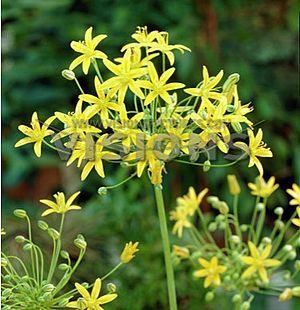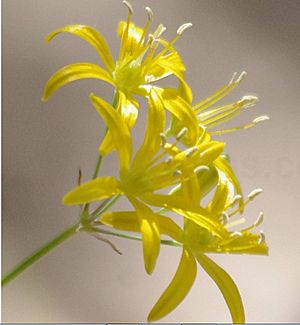Bloomeria aurea facts for kids
Quick facts for kids Bloomeria aurea |
|
|---|---|
 |
|
| Scientific classification | |
| Genus: |
Bloomeria
|
| Species: |
aurea
|
The Bloomeria aurea, also known as golden stars, is a beautiful flower. It is a type of Bloomeria plant that grows only in California. When it blooms in late spring, its bright yellow and orange colors really stand out.
Contents
Where Do Golden Stars Grow?
Golden stars like to grow in dry, flat areas and on hillsides. You can often find them on grassy slopes and ridges. They prefer heavy soils, especially in foothill forests, up to 1500 meters high. These plants live in different plant communities. These include coastal sage scrub, chaparral, valley grasslands, and oak woodlands. They are found from Baja California in Mexico, all the way up to Santa Barbara and Kern Counties in central California.
What Do Golden Stars Look Like?
Each golden star plant has a solid, round bulb underground. It has long, narrow leaves that look like grass. At the top of a tall stem, many flowers grow together in a cluster. They can look like tiny fireworks exploding!
These flowers bloom from April to June. Each flower is about an inch wide. They have small stems called pedicels that are about one and a half to two inches long. The flowers are bright orange-yellow. Inside, the pollen parts (anthers) are a vibrant green. The flowers have six equal parts. They also have six stamens, which are the parts that hold the pollen. If you look very closely, you might see tiny hairy parts at the base of the stamens. The central part of the flower, called the style, is shaped like a club. It has a three-lobed stigma at the top, which collects pollen.
After blooming, the plant forms round capsules. Each capsule holds several wrinkled seeds. The golden star plant can grow from six to eighteen inches tall. It has long, narrow, grass-like leaves. Its large flower cluster can hold around fifty blossoms!
How Are Golden Stars Used?
Can You Eat Golden Stars?
The only part of the golden star plant that people can eat is its roots. You can eat them raw. However, they don't taste very good.
Growing Golden Stars
People sometimes grow Bloomeria aurea as an ornamental plant. This means they are grown for their beauty in gardens. Special nurseries that focus on native plants sell them. These plants need a warm spot in the garden. They also need soil that drains well and is rich in nutrients. When the plants are growing, they need water. But when their leaves die back in the summer, they should be kept dry. New growth will appear in the autumn. Golden stars can handle some cold weather. They can survive temperatures down to about -5 to -10 degrees Celsius.


